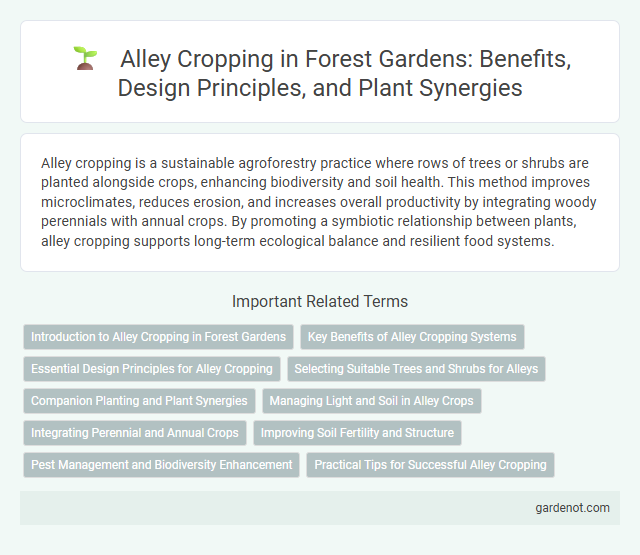Alley cropping is a sustainable agroforestry practice where rows of trees or shrubs are planted alongside crops, enhancing biodiversity and soil health. This method improves microclimates, reduces erosion, and increases overall productivity by integrating woody perennials with annual crops. By promoting a symbiotic relationship between plants, alley cropping supports long-term ecological balance and resilient food systems.
Introduction to Alley Cropping in Forest Gardens
Alley cropping integrates rows of trees or shrubs with alleyways of companion crops, enhancing biodiversity and resource efficiency in forest gardens. This agroforestry technique improves soil health, boosts crop yields, and provides habitat for wildlife by optimizing sunlight, water, and nutrient use. Implementing alley cropping fosters sustainable land management and resilience against environmental stresses within forest garden systems.
Key Benefits of Alley Cropping Systems
Alley cropping systems enhance soil fertility by integrating nitrogen-fixing trees with annual crops, reducing the need for synthetic fertilizers. This agroforestry practice improves biodiversity and promotes pest control through diverse plant species, leading to healthier, more resilient ecosystems. Increased carbon sequestration in alley cropping supports climate change mitigation while providing economic diversification for farmers via combined timber and crop yields.
Essential Design Principles for Alley Cropping
Alley cropping integrates rows of fast-growing trees or shrubs with annual or perennial crops planted in the alleys, enhancing biodiversity and soil health. Essential design principles include selecting compatible tree species for optimal shade and nutrient cycling, determining appropriate alley widths to balance sunlight penetration and crop growth, and establishing proper spacing for root systems to minimize competition. Effective management involves periodic pruning to maintain alley openness and maximize productivity in both woody and herbaceous components.
Selecting Suitable Trees and Shrubs for Alleys
Selecting suitable trees and shrubs for alley cropping in forest gardens involves prioritizing species that enhance soil fertility, provide shade, and support biodiversity. Nitrogen-fixing trees such as black locust or acacia improve nutrient cycling, while fruit-bearing shrubs like elderberry or hazelnut offer additional yields. The chosen plants must tolerate local climate conditions and be spaced to maximize sunlight penetration for the alley crops beneath.
Companion Planting and Plant Synergies
Alley cropping integrates companion planting by growing rows of trees alongside strips of annual crops, enhancing biodiversity and resource use efficiency. Plant synergies in this system include nitrogen-fixing trees that improve soil fertility and attract beneficial insects, promoting healthier crop growth. This symbiotic relationship reduces the need for chemical inputs and supports sustainable forest garden ecosystems.
Managing Light and Soil in Alley Crops
Alley cropping optimizes light capture by strategically alternating rows of nitrogen-fixing trees with wide alleys of high-value crops, enhancing photosynthesis while reducing soil erosion. Soil fertility improves through organic matter from tree litter decomposition and root biomass, supporting microbial activity and nutrient cycling. Effective management involves selecting compatible species and maintaining proper alley widths to balance shade and sunlight, ensuring sustainable productivity.
Integrating Perennial and Annual Crops
Alley cropping integrates perennial trees with annual crops by planting rows of legumes or fruit trees alongside food crops in alleyways, enhancing biodiversity and soil fertility through nitrogen fixation. This method improves microclimate regulation, reduces erosion, and increases overall yield by combining deep-rooted perennials with shallow-rooted annuals. The synergy between these plant types promotes sustainable land use and resilience in forest garden systems.
Improving Soil Fertility and Structure
Alley cropping enhances soil fertility and structure by integrating nitrogen-fixing trees with crop rows, which increases organic matter and nutrient cycling. The root systems of tree species reduce soil erosion and improve soil aggregation, promoting better water infiltration. This method creates a sustainable environment that supports diverse microbial activity and long-term soil health.
Pest Management and Biodiversity Enhancement
Alley cropping integrates rows of trees with crop alleys, creating diverse habitats that enhance biodiversity and natural pest control. The presence of various tree species supports beneficial insects and birds that prey on pests, reducing the need for chemical interventions. This agroforestry practice optimizes ecosystem services, promoting sustainable pest management and increased habitat complexity.
Practical Tips for Successful Alley Cropping
Select fast-growing nitrogen-fixing trees like Leucaena or Gliricidia to improve soil fertility and support crop growth in alley cropping systems. Maintain alley widths between 3 to 6 meters to balance tree benefits and sufficient sunlight for understory crops such as maize or beans. Implement regular pruning to recycle nutrients, reduce shading, and promote vigorous crop yields within the alley cropping framework.
Alley cropping Infographic

 gardenot.com
gardenot.com